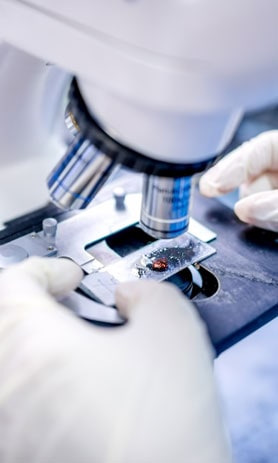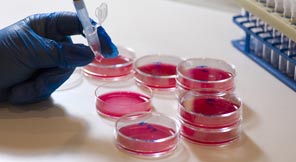High-Throughput Flow Cytometry on Adherent Cells
High-throughput flow cytometry without media removal, centrifugation or cell washing
This method offers a simple alternative to cumbersome protocols currently in use for preparing adherent cell lines for medium to highthroughput screening by flow cytometry. Routinely used protocols on adherent cells include various wash and centrifugation steps, which are not only time consuming and low-throughput but also result in cell number loss (in our experience, up to 85% in four washes). Our method offers lifting of adherent cells without removing media, eliminates wash steps, and prevents cell loss; thus allowing high-throughput flow cytometry on adherent cells in 96 and 384-well plates.
Technology Summary
Flow cytometry is a widely used technology having applications in various areas of research. One of the key requirements of using this technology lies in the use of nonadherent/floating cells that are passed through lasers for obtaining relevant data. Many of the routinely used cell culture models are adherent in nature and need several timeconsuming steps before they can be used for flow cytometry. This includes removal of growth medium, adding cell lifting solution, cell washing using multiple centrifugation steps, resuspension of cells in appropriate media, staining, and analysis using flow cytometry. Our method lifts cells within the same culture plate without undergoing any of the abovementioned steps, preventing cell loss and providing fast, hasslefree sample preparation for flow cytometry.
How It Works
 After growing the cells in an appropriate growth medium in culture plates (96 or 384 well) for an appropriate time, a chemical (SuspendC) is added to lift cells. Depending on the cell line, cells are lifted within 15−45 minutes and are ready for staining. Appropriate stain is added for desired time period and cells are analyzed using flow cytometry. A simple protocol of “add and analyze.”
After growing the cells in an appropriate growth medium in culture plates (96 or 384 well) for an appropriate time, a chemical (SuspendC) is added to lift cells. Depending on the cell line, cells are lifted within 15−45 minutes and are ready for staining. Appropriate stain is added for desired time period and cells are analyzed using flow cytometry. A simple protocol of “add and analyze.”
Why It Is Better
1. This invention solves the problem of the use of adherent cell lines for medium to highthroughput screening by flow cytometry. We devised a simple twostep process for preparing adherent cells for flow cytometry with no cell loss. The benefits include ease of use of the protocol that saves time and has broad application potential. 2. Another key advantage of this method is the separation of negative and positive control samples. The staining in negative samples is generally less than 10% and cells are stable in SuspendC for up to three hours before staining (depending on cell line) and up to two hours after staining (depending on cell line and stain). 3. No cells are lost, thus it can be applied to samples with few cells. 4. No extensive technical training is required to perform the procedure. 5. The method has reproducible results. 6. It makes highthroughput screening on adherent cells a reality.
IP Protection
KAUST has several patents pending for this technology.
Invention Track Code
2012-080

Benefits
- Proven technology: Validated on 6 cell lines, 5 assays, 2 plate formats, 2 instruments
- Two-step method: Two-steps procedure from cell lifting to flow cytometry analysis
- No media removal: The cell lifting solution is added directly to media
- Direct staining: Cells are stained in the presence of cell lifting agent and media
- Time saver: Saves time on wash steps and transfers
- Minimum cell loss: Cells are grown, lifted, and stained in the same well

Applications
Cellbased applications in:
- High-throughput screening
- Research and development (Cell signaling, apoptosis, viability)
- Drug development
- Disease diagnoses and biomarker studies

